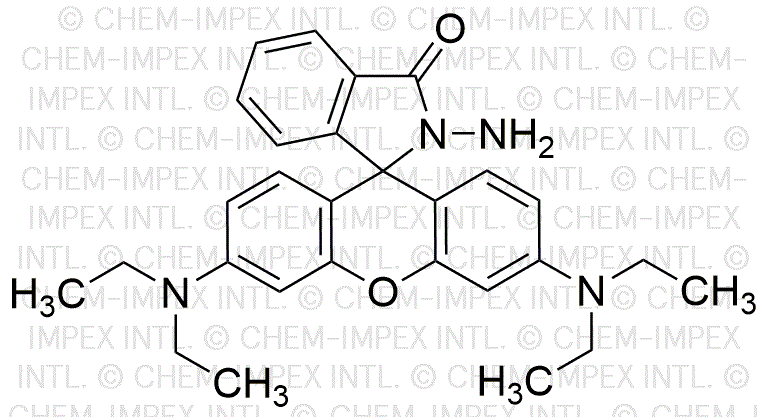Rhodamine B hydrazide is widely utilized in research focused on:
- Fluorescent Dyes: This compound serves as a vibrant fluorescent dye in biological imaging, allowing researchers to visualize cellular structures and processes with high clarity.
- Analytical Chemistry: It is employed in various analytical techniques, such as spectrophotometry, to detect and quantify metal ions, providing a reliable method for environmental monitoring.
- Textile Industry: Rhodamine B hydrazide is used as a dye in textiles, offering excellent colorfastness and vibrant hues, which enhances the aesthetic appeal of fabrics.
- Bioconjugation: The compound is useful in bioconjugation processes, where it can be linked to biomolecules for targeted drug delivery, improving the efficacy of therapeutic agents.
- Photodynamic Therapy: In medical applications, it shows promise in photodynamic therapy for cancer treatment, utilizing its fluorescent properties to activate therapeutic agents in targeted tissues.
General Information
Properties
Safety and Regulations
Applications
Rhodamine B hydrazide is widely utilized in research focused on:
- Fluorescent Dyes: This compound serves as a vibrant fluorescent dye in biological imaging, allowing researchers to visualize cellular structures and processes with high clarity.
- Analytical Chemistry: It is employed in various analytical techniques, such as spectrophotometry, to detect and quantify metal ions, providing a reliable method for environmental monitoring.
- Textile Industry: Rhodamine B hydrazide is used as a dye in textiles, offering excellent colorfastness and vibrant hues, which enhances the aesthetic appeal of fabrics.
- Bioconjugation: The compound is useful in bioconjugation processes, where it can be linked to biomolecules for targeted drug delivery, improving the efficacy of therapeutic agents.
- Photodynamic Therapy: In medical applications, it shows promise in photodynamic therapy for cancer treatment, utilizing its fluorescent properties to activate therapeutic agents in targeted tissues.
Documents
Safety Data Sheets (SDS)
The SDS provides comprehensive safety information on handling, storage, and disposal of the product.
Product Specification (PS)
The PS provides a comprehensive breakdown of the product’s properties, including chemical composition, physical state, purity, and storage requirements. It also details acceptable quality ranges and the product's intended applications.
Certificates of Analysis (COA)
Search for Certificates of Analysis (COA) by entering the products Lot Number. Lot and Batch Numbers can be found on a product’s label following the words ‘Lot’ or ‘Batch’.
*Catalog Number
*Lot Number
Certificates Of Origin (COO)
This COO confirms the country where the product was manufactured, and also details the materials and components used in it and whether it is derived from natural, synthetic, or other specific sources. This certificate may be required for customs, trade, and regulatory compliance.
*Catalog Number
*Lot Number
Safety Data Sheets (SDS)
The SDS provides comprehensive safety information on handling, storage, and disposal of the product.
DownloadProduct Specification (PS)
The PS provides a comprehensive breakdown of the product’s properties, including chemical composition, physical state, purity, and storage requirements. It also details acceptable quality ranges and the product's intended applications.
DownloadCertificates of Analysis (COA)
Search for Certificates of Analysis (COA) by entering the products Lot Number. Lot and Batch Numbers can be found on a product’s label following the words ‘Lot’ or ‘Batch’.
*Catalog Number
*Lot Number
Certificates Of Origin (COO)
This COO confirms the country where the product was manufactured, and also details the materials and components used in it and whether it is derived from natural, synthetic, or other specific sources. This certificate may be required for customs, trade, and regulatory compliance.


